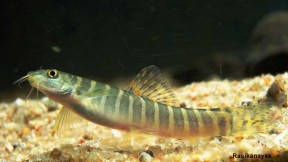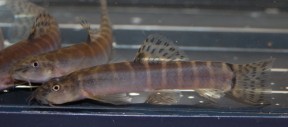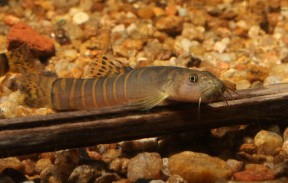Schistura denisonii
SynonymsTop ↑
Nemacheilus denisonii Day 1867; Nemacheilus chryseus Day 1873; Nemachilus dayi Hora, 1935; Noemacheilus denisoni pambaensis Menon 1987; Noemacheilus rendahli Bănărescu & Nalbant, 1968
Etymology
Schistura: from the Greek schizein, meaning ‘to divide’, and oura, meaning ‘tail’, in reference to the caudal-fin shape of many species.
denisonii: named for Sir William Thomas Denison (1804-1871), governor of Madras, India from 1861-1866.
Classification
Nemacheilidae
Distribution
The precise extent of its distribution is unclear since populations of comparable-looking fish are known from throughout the Western Ghats.
Some of these have been assigned subspecific status in the past and it remains unclear whether they represent a species complex or a single, highly-variable taxon (see ‘Notes’).
Type locality is given as ‘Bowany River’ by Day, but this now usually spelled ‘Bhavani’. The Bhavani is the largest tributary within the Cauvery River system and originates from the Nilgiri Hills in western Tamil Nadu state, southern India.
The Nilgiris are part of the larger Western Ghats range of mountains, a globally-recognised biodiversity hotspot and home to numerous endemic fish species.
Records also exist from Rajasthan state in northern India but these may require investigation.
Habitat
As is typical of many Schistura it’s known only from clear, well-oxygenated streams around watersheds and headwaters. These are often shaded by forest cover with the substrate invariably composed of coarse sand, gravel, rocks and boulders with no aquatic plants.
Flow rate and turbidity are likely to vary somewhat depending on the time of year and weather conditions, especially during the annual monsoon season.
In the Western Ghats many such habitats are being polluted by domestic and industrial waste or degraded by introduction of exotic species and large-scale sand mining operations.
In the Tunga river sympatric species include Barilius bakerii, Devario malabaricus, Danio rerio, Rasbora daniconius, Dawkinsia arulius, D. assimilis, Haludaria fasciata, Pethia ticto, Puntius sahyadriensis, ‘Puntius‘ narayani, Systomus sarana, Tor kudree, Garra mullya, Psilorhynchus tenura, Nemacheilus anguilla, Schistura nilgiriensis, S. semiarmatus, Aplocheilus blockii, A. lineatus, Pristolepis marginata, and Channa gachua.
Maximum Standard Length
45 – 52 mm.
Aquarium SizeTop ↑
Even a small group will need an aquarium with base dimensions of 75 ∗ 30 cm or similar.
Maintenance
Not difficult to maintain under the correct conditions. We strongly recommend keeping it in a tank designed to resemble a flowing stream or river with a substrate of variably-sized rocks, sand, fine gravel, and some water-worn boulders.
This can be further furnished with driftwood branches arranged to form a network of nooks, crannies, and shaded spots, thus providing broken lines of sight.
While the majority of aquatic plants will fail to thrive in such surroundings hardy types such as Microsorum, Bolbitis, or Anubias spp. can be grown attached to the décor.
Once acclimatised individuals tend to select a particular cave or sheltered space which they defend against conspecifics and similar-looking species so it’s important to provide a well-structured environment.
It will thrive in this kind of set-up and can be kept alongside other species that enjoy similar conditions (see ‘Behaviour and Compatibility’).
Though torrent-like conditions are unnecessary it does best if there is a high proportion of dissolved oxygen and some water movement in the tank so power filter(s), additional powerhead(s), or airstone(s) should be employed as necessary.
Like many fishes that naturally inhabit running water it’s intolerant to accumulation of organic pollutants and requires spotless water in order to thrive. Weekly water changes of 30-50% tank volume should therefore be considered routine.
Water Conditions
Temperature: 18 – 24 °C
pH: 6.0 – 7.5
Hardness: 36 – 215 ppm
Diet
Schistura species are omnivorous although the bulk of their diet consists of small insects, worms, crustaceans, and other zooplankton with only relatively small amounts of plant matter and other organic detritus consumed.
In the aquarium they will accept dried foods of a suitable size but should not be fed these exclusively.
Daily meals of small live and frozen fare such as Daphnia, Artemia, bloodworm, etc., will result in the best colouration and condition. In a set-up with moving water they will often shoot up to snatch morsels passing in the flow.
Behaviour and CompatibilityTop ↑
This species is feisty and largely unsuitable for the general community aquarium. This is not to say it must be kept alone, rather that tankmates must be selected with care and proper research.
Slow-moving or long-finned species should certainly be omitted because they’re likely to struggle with the necessary level of water movement and may end up with nipped fins.
Placid bottom-dwellers such as Corydoras or Pangio spp. also tend to be easy targets for territorial Schistura and are best avoided.
Fishes which inhabit similar biotopes in nature, especially those which swim in open water such as Danio, Devario, Mystacoleucus, smaller Barilius, Pethia, Puntius, and Rasbora spp. constitute the best options, and one or two schools can make a visible difference to the confidence of this naturally reclusive loach.
Other possibilities include current-loving loaches from genera such as Pseudogastromyzon, Beaufortia, or Sewellia plus benthic cyprinids such as Crossocheilus and Garra spp.
Similarly-shaped relatives like Nemacheilus, Acanthocobitis, and other Schistura spp. aren’t recommended under most circumstances although a combination may work in larger aquaria.
While it can’t be described as gregarious a group can be maintained together provided the set-up contains plenty of rocky structures and broken lines of sight.
Occasional skirmishes may occur, however, and in small or sparsely-decorated tanks conspecific aggression may escalate to an unacceptable level.
Sexual Dimorphism
Sexually mature males appear to develop enlarged lips and mouthparts as in some other members of the genus.
Reproduction
Unreported.
NotesTop ↑
This species is widely referred to as being a member of the genus Nemacheilus but in reality matches diagnostic characters for Schistura as listed below (Bănărescu & Nalbant, 1995).
It can be distinguished from congeners by the following combination of characters: lateral line incomplete; body with variable number of light bars; a black spot at the anterior dorsal-fin base; caudal-fin deeply emarginate with several rows of spots; dorsal-fin with row of spots; body depth fits 5-5.5 times in SL; pelvic-fin reaching anus.
In the original description Day describes the colour pattern as ‘of a light, rich, reddish-brown colour’ and the fish to have 12 vertical body bars which ‘regularly coalesce along the back’ anterior to the dorsal-fin.
In nature however it’s highly variable, particularly with regard to the number, form, and arrangement of the vertical body bars.
Differently-patterned individuals have been observed both between and within populations, and it remains unclear if they represent a complex of species or single taxon.
Some have been raised to subspecific status in the past; Menon (1987) named a form from close to Mookambika, Karnataka state with 5-6 vertical body bars Noemacheilus denisonii mukambbikaensis (Menon, 1987) and another from Sabarigiri, Kerala state with 10-14 vertical bars N. d. pambaensis.
However while the latter is currently considered synonymous with S. denisonii, Schistura mukambbikaensis (Menon 1987) is reported to be a valid, distinct species in Kottelat (2012).
Schistura is the most species-rich genus among nemacheilid loaches with some 190 members and it continues to grow with over 100 having been described since 1990.
It may represent a polyphyletic lineage and is often arranged into a number of loosely-defined species ‘groups’, some of which are quite dissimilar to one another.
Among these are an assemblage in which some or all of the body bars are vertically split and another which exhibit reductions in body size (adult size <50 mm SL), the number of pelvic and pectoral-fin rays and often the number of caudal-fin rays and lateral line length, for example.
Some species, such as S. geisleri, also appear to be unrelated to any of the others.
Most inhabit flowing streams or areas close to waterfalls where there naturally exist high concentrations of dissolved oxygen, and a handful are troglobytic, i.e., cave-dwelling, in existence. The latter have reduced pigmentation and are completely blind in many cases.
Schistura spp. are distinguished from other nemacheilids by a combination of morphological characters which include: a moderately arched mouth which is 2-3.5 times wider than it is long; a median ‘interruption’ in the lower lip which does not form two lateral triangular pads and can vary from smooth to furrowed in texture; diverse colour pattern but usually dark with relatively regular bars; usually a black bar at the caudal-fin base which can be broken into two spots or smaller bars; one or two black markings along the base of the dorsal-fin; lack of acuminate scales on the caudal peduncle; caudal-fin shape variable from truncate to forked but usually emarginate; presence or absence of a median notch in the lower jaw; clear sexual dimorphism in some species.
The family Nemacheilidae is widely-distributed across most of Eurasia with the Indian subcontinent, Southeast Asia and China representing particular centres of species diversity.
References
- Day, F., 1867 - Proceedings of the Zoological Society of London 1867 (pt 2): 281-302
On the fishes of the Neilgherry Hills and rivers around their bases. - Kottelat, M., 1990 - Verlag Dr. Friedrich Pfeil, München: 1-262
Indochinese nemacheilines. A revision of nemacheiline loaches (Pisces: Cypriniformes) of Thailand, Burma, Laos, Cambodia and southern Viet Nam. - Kottelat, M., 2012 - Raffles Bulletin of Zoology Supplement 26: 1-199
Conspectus cobitidum: an inventory of the loaches of the world (Teleostei: Cypriniformes: Cobitoidei). - Madhusoodana Kurup, B. and K. V. Radhakrishnan, 2005 - Journal of the Bombay Natural History Society 102(1): 75-78
Fishes of the genus Nemacheilus (Bleeker 1863) in Kereala with description of a new species, Nemacheilus periyarensis. - Sreekantha, [no initial], K. V. Gururaja, K. Rema Devi, T. J. Indra and T. V. Ramachandra, 2006 - Zoos' Print Journal 21(4): 2211-2216
Two new species of the genus Schistura McClelland (Cypriniformes: Balitoridae) from western Ghats, India. - Tang, Q., H. Liu, R. Mayden, and B. Xiong, 2006 - Molecular Phylogenetics and Evolution 39(2): 347-357
Comparison of evolutionary rates in the mitochondrial DNA cytochrome b gene and control region and their implications for phylogeny of the Cobitoidea (Teleostei: Cypriniformes). - Šlechtová, V., J. Bohlen and H. H. Tan, 2007 - Molecular Phylogenetics and Evolution 44(3): 1358-1365
Families of Cobitoidea (Teleostei; Cypriniformes) as revealed from nuclear genetic data and the position of the mysterious genera Barbucca, Psilorhynchus, Serpenticobitis and Vaillantella.












